冬に備える:スキーに最適な10のエクササイズ


人類はこれまで数々の素晴らしい発明をしてきましたが、スキーはおそらく史上最高の発明の一つと言えるでしょう。肉体の限界に挑戦し、自然の中で過ごし、まるでバターのように滑らかな雪面と熱いスキー板のカービングを楽しめる機会は、そうそうあるものではありません。とはいえ、スキーは体力的に厳しいアクティビティであり、万全の準備を整えることが重要です。スキーのためのトレーニングは、安全を確保し、体調を維持し、いざカービングの時が来たら山を制覇するために不可欠です。
私と同じくらいスキーが好きなら、シーズン開幕前に体力と健康を整えておきたいですよね。冬が近づいてきた今こそ、スキーのためのエクササイズを始める絶好のタイミングです。スキーのための脚のエクササイズはもちろん重要ですが、スキーは全身を使うスポーツであり、全身を鍛えることがゲレンデで最高の体型を手に入れる鍵となることを忘れてはなりません。何から始めたらいいのかわからないという方でも大丈夫。私たちがリサーチを行い、この冬のスキーに向けて準備するためのエクササイズをまとめました。最後に、このリストを見ていく前に、以下のエクササイズはスキーヤー向けに厳選されたもので、スノーボーダー向けではありません。これらのエクササイズの多くはスノーボーダーにも効果的かもしれませんが、このリストはスキーヤー向けに作成しました。
スキーのための10のエクササイズ
10種類と聞くと多すぎるように思えるかもしれませんが、これらのエクササイズはそれほど難しくありません。ほとんどのエクササイズは、自宅や裏庭で快適に行うことができます。 カナンとシャーロット・ベネット(動画をご覧ください)の指導を受ければ、これらのエクササイズに取り組む際に正しいフォームを意識することができます。カナンはフロリダ州ボカラトン在住のベテランフィジカルトレーナーです。
このリストに入る前に、一つ明確にしておきたいことがあります。これらのエクササイズはスキーの準備のために設計されており、スキー中の安全と健康を維持できると考えて選んだのです。ですから、これらのエクササイズを行う際は、特に熱心に行う必要があります。つまり、正しいフォームで、しっかりと行う必要があります。怪我をしてしまうようでは、これらのエクササイズを行う意味がありません。良い体力には良いエクササイズが必要であり、良いエクササイズには良いフォームが不可欠であることを忘れないでください。さあ、始めましょう。
1. ブルガリアン・スプリット・スクワット
スクワットには様々な種類がありますが、このスクワットほど脚全体を鍛えられるものはありません。スキーは全身を使うスポーツですが、脚をかなり使うので、スキーのための脚のトレーニングは重要です。スキーのために脚を鍛える場合、効果を得るために大量の重量を扱う必要はありません。
例えば、ブルガリアン・スプリット・スクワットは、ウェイトを一切使用しません。このスクワットは、速くても遅くても行うことができます。速く行うことで、斜面で必要となる爆発的なパワーに必要な脚の筋肉を鍛えることができ、ゆっくり行うことで、安定性とコントロール性を高めることができます。
ブルガリアン・スプリット・スクワットのやり方:
- 椅子、ベンチ、箱など(または後ろ足を支えるのに使えるものなら何でも)を用意します。
- 後ろ足を上げたまま、前足を少し前に出します。前足の膝は後ろ足のすぐ上に来るようにします。
- 太ももが水平になるまでしゃがみます。
- 力を入れて押し上げます。
- これを繰り返します(10回スクワットを3セット)
2. ボックスジャンプ
ボックスジャンプは、プライオメトリックトレーニングのカテゴリーに当てはまるため、スキーの準備に最適な方法です。つまり、ボックスジャンプは爆発的なパワー、筋持久力、そして心肺機能の向上に役立ちます。ボックスジャンプがない場合は、ステップ、レッジ、または体重を支えられる垂直のプラットフォームなどを見つけてください。
これも追加の重量を必要としないエクササイズです。ジャンプして踏み出すだけで、バランス感覚、敏捷性、可動性、協調性、そしてスピードが向上します。
ボックスジャンプのやり方:
- 目の前に箱を置き、足を肩幅に広げます。
- 膝を曲げて、十分な力で箱の上にジャンプします。
- 体全体を使いましょう!腕を振ったり、背中を曲げたりするのが効果的であれば、そうしましょう。
- これを繰り返します(10回ジャンプ×3セット)
3. レッグエクステンション(軽量のみ)
これは自宅でできない唯一のエクササイズかもしれません。レッグエクステンションが膝に良いのか悪いのかは長年議論されてきました。しかし、言うまでもなく、大腿四頭筋(太ももの上部)を強くすることが、膝を健康に保ち、怪我を防ぐ上で重要な役割を果たします。強い大腿四頭筋は衝撃を吸収する際に膝のクッションのような役割を果たし、スキーは膝にとって大きな衝撃を与える可能性があります。
レッグエクステンションは大腿四頭筋を鍛えるのに最適な方法ですが、マシンに負荷をかけすぎると膝を痛める可能性があるため、行う際には注意が必要です(これは絶対に避けるべきことです!)。アーノルド・シュワルツェネッガーのような体型を目指しているのではなく、スキーに適した体型を目指しているだけなのです。このエクササイズで少しでも不快感を感じたら、すぐに中止してください。
レッグエクステンションのやり方:
-
レッグエクステンションマシンに座り、楽な重量であることを確認します。
パッド付きの足首バーの下に足を置き、足を天井に向かって押し上げます。
これを繰り返します(10回×3セット)
4. 自重スクワット
おそらく、このエクササイズは以前にもやったことがあるでしょう。このリストの中で一番簡単で基本的なエクササイズですが、その効果は紛れもなく素晴らしいものです。ダウンヒルスキーのエクササイズといえば、自重スクワットは欠かせません。
このタイプのスクワットは、様々な点で効果があります。ふくらはぎ、大腿四頭筋、ハムストリングスを強化します。また、腰も強化し、下半身の可動域を広げます。これは、必ず正しいフォームで行うべきエクササイズの一つです。ゲレンデを降りた時に良いフォームを維持しておけば、ゲレンデ上でも良いフォームを維持できます。
自重スクワットのやり方:
- 足を肩幅に広げ、腕を伸ばして安定性を高めます。
- できるだけ深くしゃがみます。
- 立ち上がって次の準備をしましょう。
- これを繰り返します(20回×3セット)
5. 壁座り
さあ、これで脚に関する最後のエクササイズです、約束します。ウォールシットは…そうです、壁があればどこでもできます。ウォールシットは、自重スクワットを最も難しいポジションで保持するようなものです。
これは等尺性運動で、健康的な筋肉の緊張を高め、関節の安定性を高めます。もちろん、ウォールシットはふくらはぎ、大腿四頭筋、ハムストリングスの筋肉を鍛えるだけでなく、スキーで山を滑降する際により安定感を得られます。さらに、このエクササイズはスキーの準備に不可欠な体幹を鍛えます。
壁に座る方法:
- 足を肩幅に広げ、平らな地面に対してスクワットのような姿勢になります。
-
この姿勢をできるだけ静止した状態に保ちます(彫像のふりをします)
これを繰り返します(1分ずつ3セット、またはもうできなくなるまで)。
6. デッドリフト
脚に重点を置いたエクササイズはこれで終わりです。デッドリフトは確かに大腿四頭筋と臀筋に効果的ですが、特に腰の筋肉と体幹に効果的です。急なターンやモーグルを打つ際には、背骨に大きな負担がかかります。そのため、体に必要なサポートを与えるために、背骨にクッション性を持たせることが重要です。
このエクササイズは、胴体、腰、そして体幹を引き締め、安定させます。とはいえ、これは100%正しく行うことが重要な動作の一つです。間違ったフォームでデッドリフトを行うと、腰を痛めてしまう可能性があります。スキーを目的としたデッドリフトでは、それほど重い重量を使う必要はありません。軽いダンベルかスクワットバーがあれば、このエクササイズに最適です(動画をご覧ください)。最も重要なのは、背中をまっすぐに保つことです。
デッドリフトのやり方:
- 足を肩幅に広げ、膝を少し曲げた状態にします。
- ゆっくりと、背筋を伸ばしたまま、コントロールしながら上半身を曲げ、また元に戻します。
- これを繰り返します(10~15回×3セット)
7. プランクとサイドプランク
体幹の安定といえば、プランクは体幹を安定させるために考案されたエクササイズです。プランクのやり方はとてもシンプルです。背中をまっすぐにし、お尻を下げるだけで、腹筋が引き締まり、体幹の筋肉の持久力が向上します。
この静的エクササイズは、スキー中に避けられない転倒から背骨を守るのに最適です。プランクは、横隔膜、骨盤底筋、内腹斜筋、腹筋などの筋肉に効果があります。体幹が強く、背中が安定していれば、一日中スキーをしても問題ありません。プランクの難易度を上げたい場合は、片側を向いてその姿勢を保つのも良いでしょう。
プランクとサイドプランクのやり方:
- プランクを行うには、平らな面を見つけるだけです。
- 肘または手のひらを上にして体をできるだけまっすぐにし、お腹が地面に触れないようにします。
- この姿勢を長時間維持します。
- このエクササイズを繰り返します(1分ずつ3セット)
8. ロシアンツイスト
最初はブルガリアン・スプリット・スクワット、そして今度はロシアン・ツイストです。ロシアン・ツイストは、文字通りどこからでも体幹を鍛えられる素晴らしい方法です。このエクササイズの素晴らしいところは、運動器具を一切必要としないことです。
ロシアンツイストは体幹を鍛えるのに効果的ですが、バランス感覚、協調性、柔軟性(スキーに必要な要素すべて!)を向上させることができるため、このエクササイズを選びました。この動きで足を空中に浮かせ続けるのが難しい場合は、足を地面につけたままツイストをしてみてください。体幹が強くなるにつれて、足を空中に浮かせている時間が長くなります。
ロシアツイストのやり方:
- 平らな場所を見つけて、背中と足を同時に地面から離した状態で座ります。
- 上半身を左右にひねりながら、横の地面に触れます。
- 足を同じ位置に保ち、ひねりが完全に完了していることを確認します(ごまかしなし)。
- これを繰り返します(18回×3セット)
9. バーピー
全身運動の準備はできていますか?スキーの練習と同じように、バーピーはまさにその効果を発揮します。繰り返しますが、このエクササイズは器具を必要としません。バーピーは、ふくらはぎ、大腿四頭筋、ハムストリング、臀部、腰、体幹、胸、そして腕を鍛えることができます。控えめに言っても、効果的なエクササイズです。
スキーは決して簡単ではありません。特に、難関のダブルブラックダイヤモンドコースで長い時間を過ごすとなるとなおさらです。全身を万全の状態に整え、どんな状況にも対応できる準備を整えることが、この冬を安全で健康に過ごす唯一の方法です。筋持久力を高めるのに最適なバーピーは、このリストの中で最も簡単な運動ではありませんが、最も効果的な運動かもしれません。バーピーは難しいので、無理のない範囲で行ってください。
バーピーのやり方:
- できるだけ早く床に行き、腕立て伏せをします。
- 一気にしゃがんだ姿勢から立ち上がり、一気にジャンプします。
- 良い姿勢で着地し、もう一度やり直してください。
- これを繰り返します(10回×3セット、または5回×6セット)
10. 縄跳び – 有酸素運動
最後に、有酸素運動をご紹介します。ジョギング、サイクリング、ボート漕ぎ、水泳など、どんな有酸素運動でも構いませんが、スキーに効果があるという理由から縄跳びを選びました。縄跳びはジョギングよりも膝への負担が少なく、より多くのカロリーを消費することが証明されています。縄跳びで下腿に使われる爆発的な力は、スキーに向けてふくらはぎを鍛えるのに最適な方法です。
縄跳びをお持ちでない場合は、ジョギングなどの有酸素運動で十分です。縄跳びの代わりにサイクリングは最適かもしれません。自転車は衝撃が少なく、体に負担をかけずに体を動かすのに最適な方法です。ただし、 ヘルメットは必ず着用してください。有酸素運動は、スキーや山の高地にも対応できる心血管系を鍛えるのに役立ちます。
スキーの準備はできていますか?
スキーシーズンに向けて、そろそろ準備を始めませんか?アウトドアマスターでは、スキー以外にも必要なアイテムを豊富に取り揃えています。
ジョギング用のサングラスが必要ですか?新しいスキーゴーグルが必要ですか? スノーギア全般が必要ですか?Outdoor Masterに準備のお手伝いをさせていただき、最高のスキーシーズンをお過ごしください!





